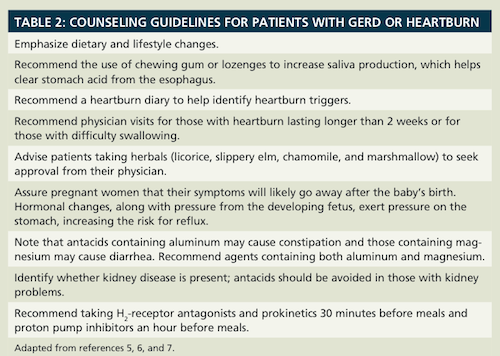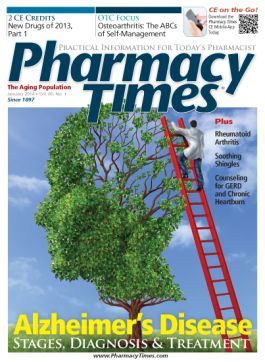Publication
Article
Pharmacy Times
GERD & Chronic Heartburn: Counseling Patients
Author(s):
Left untreated, gastroesophageal reflux disease results in significant complications.
Left untreated, gastroesophageal reflux disease results in significant complications.
Heartburn occurs when stomach contents reflux into the esophagus. When episodes occur regularly over a 2-week period, the affected person likely has gastroesophageal reflux disease (GERD). Symptoms include heartburn, regurgitation, vomiting, and difficulty or pain on swallowing. The reflux of stomach acid into the mouth adversely affects vocal cords, leading to hoarseness or aspiration into the lungs. Left untreated, GERD causes significant damage, including ulcers; esophageal strictures, making swallowing difficult; aspiration pneumonia; chronic sore throat; and Barrett’s esophagus (normal cells lining the esophagus are replaced with intestinal cells, increasing the risk for esophageal cancer).1
Approximately 55% to 65% of people experience intermittent reflux symptoms. Surveys report that approximately 20% of the population experiences weekly heartburn.2,3 Other studies, however, report that up to 50% of the population experiences weekly heartburn.4
Pathophysiology
The pathogenesis of GERD is multifactorial, involving transient lower esophageal sphincter relaxations and other lower esophageal sphincter pressure abnormalities, resulting in reflux of acid, bile, pepsin, and pancreatic enzymes that cause mucosal injury. Other factors contributing to pathophysiology include hiatus hernia, impaired esophageal clearance, delayed gastric emptying, and impaired mucosal defensive factors. Up to 33% of patients with GERD have delayed gastric empting, resulting in a greater volume of stomach contents and more time for them to be refluxed.3,5
Nocturnal reflux is associated with more severe symptoms, such as esophagitis. Unlike daytime reflux, nocturnal reflux tends to be longer and resolves more slowly, resulting in greater damage. Laryngitis, pharyngitis, asthma, and aspiration pneumonia are more common in patients with nocturnal reflux.4
Treatment

GERD treatment has 3 goals: symptom control; treatment of reflux esophagitis and related conditions; and prevention of further complications. Lifestyle changes are recommended for symptom control for those with mild to moderate GERD severity (Table 1). When lifestyle changes are inadequate, antacids, histamine2 (H2)-receptor antagonists, proton pump inhibitors (PPIs), or prokinetics are recommended.
Antacids are recommended for treating heartburn and mild GERD. Although antacids neutralize stomach acid, their action is brief—usually less than an hour. They achieve optimal relief when taken 1 hour after meals, which is when reflux usually occurs. A second dose is recommended 2 hours after eating. Antacids containing aluminum may cause constipation, and those containing magnesium may cause diarrhea. Calcium-containing antacids are not recommended because they lead to acid rebound in the stomach.
When antacids fail to control symptoms, treatment using H2-receptor antagonists is recommended. Histamine stimulates acid-producing cells in the stomach’s wall; H2-receptor antagonists work by blocking H2 receptors, preventing histamine from stimulating acid-producing cells.
H2-receptor antagonists are effective for relieving symptoms, especially heartburn, but are ineffective in reducing esophagitis. Cimetidine, ranitidine, nizatidine, and famotidine are available by prescription and over the counter at lower doses.7 Side effects include headache, dizziness, diarrhea or constipation, nausea, and vomiting.5 H2-receptor antagonists are most effective when taken 30 minutes before meals. H2-receptor antagonists can also be taken at bedtime to suppress nocturnal reflux.
PPIs block the secretion of stomach acid but are more effective than H2-receptor antagonists because PPIs decrease acid production more completely and for a longer period of time. PPIs are generally used for moderate to severe GERD. Five PPIs are approved for treating GERD— omeprazole, lansoprazole, rabeprazole, pantoprazole, and esomeprazole.
Omeprazole is also available as an OTC product. PPIs are best taken an hour before meals so that the agents are at their peak levels when the stomach is most actively producing acid.7 Headache and diarrhea are frequent side effects.5 Interestingly, patients report higher levels of satisfaction with PPIs compared with H2-receptor antagonists and prokinetics.8
Prokinetics or promotility agents stimulate muscles of the gastrointestinal tract, including the esophagus, stomach, small intestine, and colon. Prokinetics increase pressure in the lower esophageal sphincter that strengthen esophageal contractions. Of existing agents, only metoclopramide has been approved for GERD, which is particularly effective in facilitating stomach emptying. Prokinetics are generally reserved for patients who do not respond to other agents.7,9
Counseling Guidelines
Counseling begins by reviewing prescribed agents. For those seeking help without a prescription, pharmacists should first recommend antacids and then, if they are inadequate, H2-receptor antagonists. Table 2 presents counseling guidelines.

Final Thought
Given the array of products for heartburn and GERD, consumers often turn to pharmacists for recommendations. Listening carefully to consumers’ symptoms is paramount in providing effective counseling.
Dr. Zanni is a psychologist and health-systems consultant based in Alexandria, Virginia.
References:
- Kahrilas P. Patient information: acid reflux (gastroesophageal reflux disease) in adults (beyond the basics). Wolters Kluwer Health. www.uptodate.com/contents/acid-reflux-gastroesophageal-reflux-disease-in-adults-beyond-the-basics. Accessed May 31, 2013.
- Locke G. What is the prevalence of gastroesophageal reflux disease in a population-based study? www.hon.ch/OESO/books/Vol_5_Eso_Junction/Articles/art126.html. Accessed May 31, 2013.
- De Giorgi F, Palmiero M, Esposito I, Mosca F, Cuomo R. Pathophysiology of gastro-oesophageal reflux disease. Acta Otorhinolaryngol Ital. 2006;26(5):241-246.
- Boeckxstaens GE. Review article: the pathophysiology of gastro-oesophageal reflux disease. Aliment Pharmacol Ther. 2007;26(2):149-160.
- WebMD. Heartburn/GERD health center. www.webmd.com/heartburn-gerd/should-i-use-medications-or-surgery-to-treat-gastroesophageal-reflux#uf10108. Accessed May 31, 2013.
- Mayo Clinic. GERD. www.mayoclinic.com/health/gerd/DS00967/DSECTION=treatments-and-drugs. Accessed May 31, 2013.
- Marks J. Gastroesophageal reflux disease. www.medicinenet.com/gastroesophageal_reflux_disease_gerd/article.htm. Accessed May 31, 2013.
- van Zanten SJ, Henderson C, Hughes N. Patient satisfaction with medication for gastroesophageal reflux disease: a systematic review. Can J Gastroenterol. 2012;26(4):196-204.
- The Gastroparesis and Dysmotilities Association. Understanding GP. www.digestivedistress.com/motility-rx. Accessed June 1, 2013.







